Few exercises are as prized as the push-up.
It’s held in such high esteem because it’s one of the most effective and efficient exercises you can do.
It trains most of your upper-body muscles, requires no equipment and little space, and it’s easy to learn and highly scalable.
No matter how strong you are, there’s a push-up alternative that’ll challenge you.
In this article, you’ll learn what a push-up is, its benefits, which muscles it works, how to do a push-up using proper form, the best push-up variations and push-up workouts, and more.
Table of Contents
+
What Is a Push-up?
The push-up is a bodyweight exercise that involves lying prone on the floor and raising and lowering your body by straightening and bending your arms.
Most fitness experts consider the push-up a “foundational exercise.” This means it’s a basic movement but one that’s vital for learning more complex exercises involving a similar movement pattern.
For example, the push-up is the most basic version of an exercise that involves pushing horizontally away from your body. Learning how to do the push-up correctly enables you to better perform other, more advanced exercises, such as the bench press, dumbbell bench press, and incline bench press.
Push-up: Benefits
1. It trains several muscle groups.
The push-up effectively trains several upper-body muscle groups, including the pecs, shoulders, triceps, serratus anterior, biceps, lats, infraspinatus, and core.
Unlike most compound chest exercises, the push-up is also a closed-kinetic-chain exercise—an exercise where your hands or feet are fixed on a stationary object. In the case of the push-up, your hands and feet are fixed to the floor, whereas in the bench press, for example, a bench supports your back so you can move your hands and feet freely.
One of the benefits of closed-kinetic-chain exercises is that they require more balance and stability than open-chain-kinetic exercises, which means they train “stabilizer” muscles across your entire body to a higher degree.
2. It‘s highly scalable.
Many people think of the push-up as a “beginner exercise,” but it requires more strength than most realize.
Research shows that to complete a push-up, you have to support ~70% of your body weight when your arms are straight and ~75% of your body weight when your arms are bent.
This is why the regular push-up isn’t always the best place to start for people who are new to strength training.
Fortunately, there are push-up alternatives, including the knee push-up and incline push-up, that help you build the strength you need to progress to the regular push-up.
For example, in the knee push-up, you support your lower body on your knees instead of your feet, reducing the amount of weight you have to lift (~54% and ~62% of your body weight when your arms are straight and bent, respectively).
Once you’re strong enough to do several reps (usually around 20) of the “full” push-up, you can progress to more challenging variations, including the decline push-up, band push-up, and deficit push-up.
Thus, no matter how strong you are, there’s a push-up alternative that’ll suit your experience and strength level and challenge you to get stronger over time.
3. It’s easy to learn.
When most people think of “pushing” exercises, they think of barbell exercises like the bench press, incline bench press, and overhead press.
While it’s true that these are among the best exercises for developing your chest, shoulders, and triceps, they’re not always a great place to start if you’re new to weightlifting. That’s because newbie weightlifters often lack the requisite strength and skill to perform these exercises safely and effectively.
The push-up trains your upper body similarly to the barbell exercises above, but it’s easier to learn and allows you to start with just your body weight and build strength over time. This makes it a fantastic option for people who are new to strength training, especially if they don’t want to go to the gym (yet!).
4. It requires no equipment.
You don’t need any equipment or much room to perform the push-up, which makes it an excellent option for people who want to work out at home or while traveling.
That said, if you experience wrist or shoulder discomfort while performing the push-up, or if you want to make the push-up more difficult by extending the range of motion, buying a set of push-up bars (also called push-up handles) is worthwhile.
Likewise, if you want to add extra resistance to the push-up, investing in a set of resistance bands that you can wrap around your back while performing the push-up is a workable solution.
5. It’s functional.
The push-up mimics many everyday movements, such as getting up from the floor, shoving open a door, or pushing a shopping cart or baby stroller.
Using the push-up to train the muscles involved in these movements helps develop strength that makes day-to-day activities easier.
Push-up: Muscles Worked
The main muscles worked by the push-up are:
- Pectoralis major (both the sternocostal and clavicular heads)
- Anterior deltoid
- Triceps brachii
It also trains your lats and core to a lesser extent. Here’s what the primary muscles worked by the push-up look like on your body:
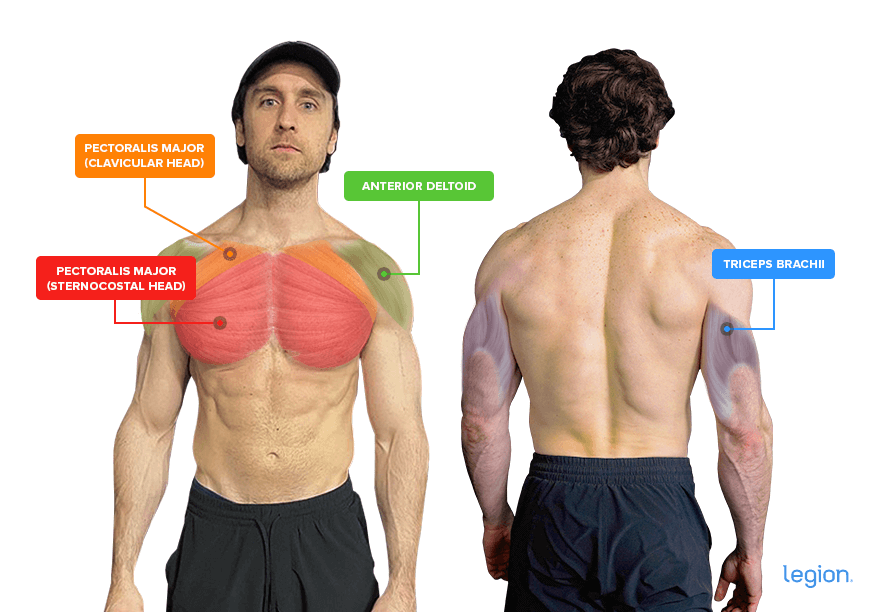
How to Do the Push-up
The best way to learn how to do a push-up is to split the exercise into three parts: set up, descend, and push.
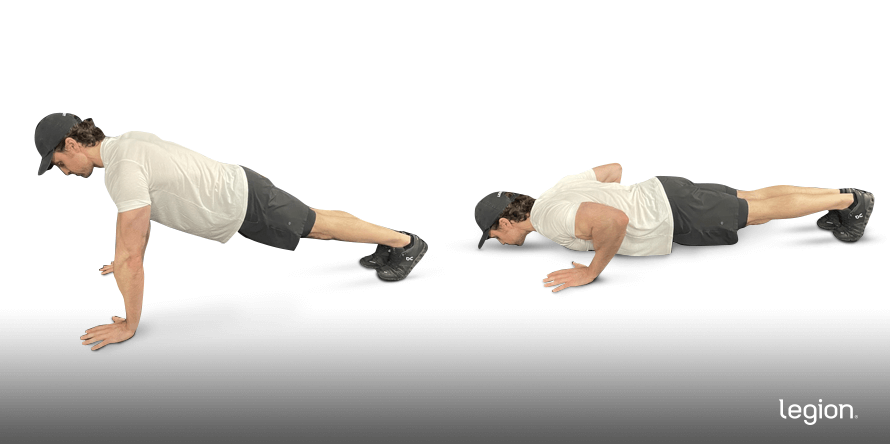
1. Set up
Get on all fours and place your hands slightly wider than shoulder-width apart. Extend your legs behind you, so you support your body weight on your hands and toes, and your body forms a straight line from your head to your feet (don’t lift your butt or let your hips sag).
You can keep your feet together or place them slightly apart if it helps you balance.
Squeeze your shoulder blades together and tuck them down. A good cue is to think of pulling your shoulder blades into your back pockets.
2. Descend
Keeping your back straight, lower your chest to the floor by bending your elbows. Allow your elbows to flare slightly—at the bottom of each rep they should be 6-to-8 inches from your torso.
3. Push
Once your chest is 1-to-2 inches from the floor, push your body back to the starting position, making sure to keep your shoulder blades squeezed together and tucked down as you push up. This is a mirror image of what you did during the descent.
Here’s how it should look when you put it all together:
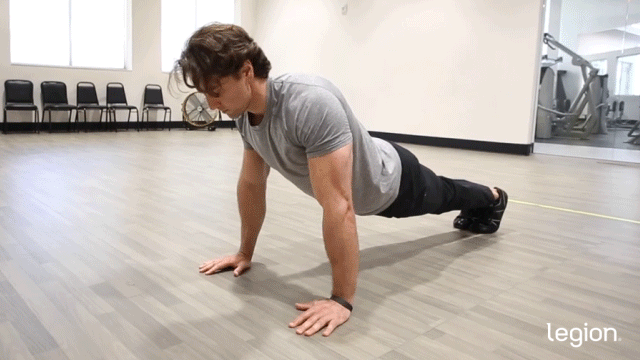
The Best Push-up Variations
1. Knee Push-up
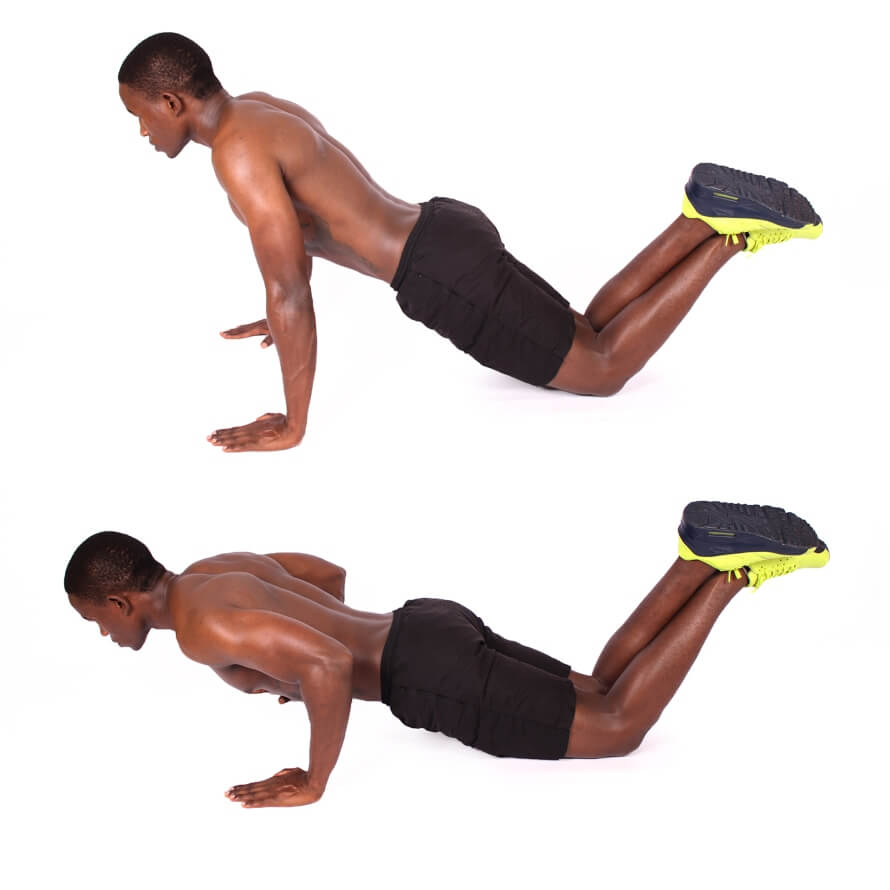
Performing the push-up on your knees reduces the weight your upper body has to lift, which makes the knee push-up the best push-up variation for new weightlifters who haven’t gained enough strength to do the regular push-up yet.
2. Incline Push-up
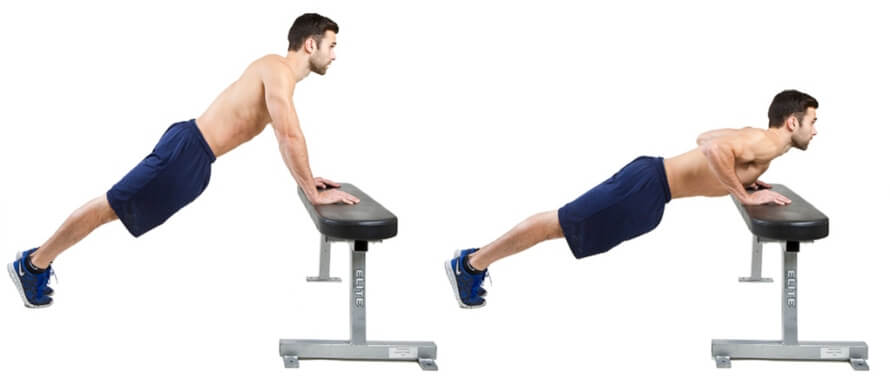
In the incline push-up, you place your hands on an object 1-to-2 feet off the floor. This makes it easier than the regular push-up, which means it’s an excellent variation for new weightlifters who aren’t strong enough to perform a regular push-up yet.
Some more advanced weightlifters also think of the incline push-up as the “lower chest push-up.” That is, they believe that the incline push-up trains your lower chest more than the regular push-up because of the angle of your torso.
However, this probably isn’t true—the regular push-up trains all parts of the pecs, and since it involves lifting more of your body weight, it’s probably better at training your “lower pecs” than the incline push-up.
3. Decline Push-up
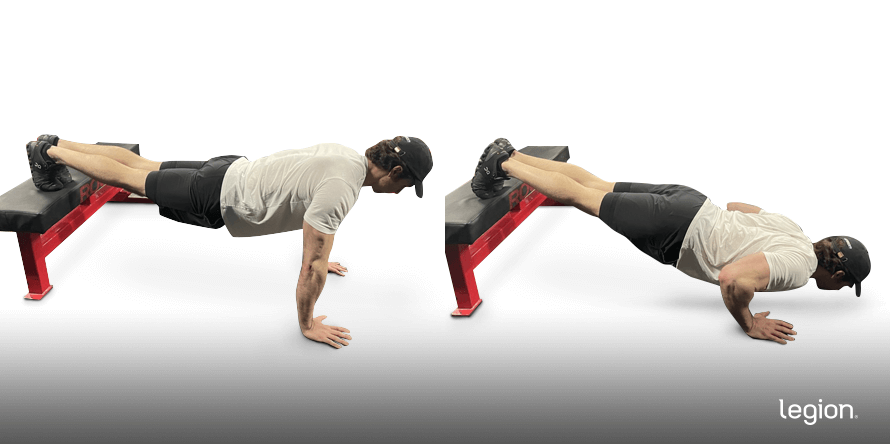
In the decline push-up, you place your feet on an object 1-to-2 feet off the floor. This makes the exercise slightly more difficult than the regular push-up and means it emphasizes the “sternocostal” head (“upper” portion) of the pecs.
4. Hand-Release Push-up

When you perform the hand-release push-up, you start every rep with your chest on the floor and your hands 1-to-2 inches off the floor. This means you can’t use the momentum from the previous rep to “bounce” out of the bottom position, which helps you develop more strength and power.
5. Handstand Push-up
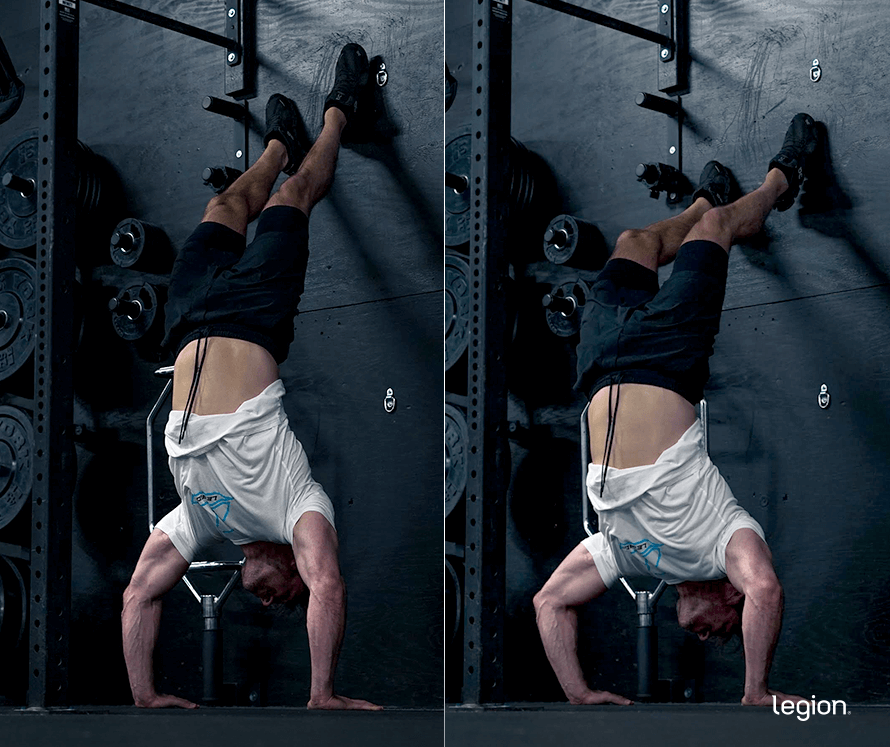
The handstand push-up primarily trains your shoulders, triceps, and upper back, though your “upper chest” is also heavily involved. Furthermore, the handstand push-up requires exceptional balance and coordination to prevent yourself from toppling, which means it trains stabilizer muscles throughout your body, too.
6. Band Push-up
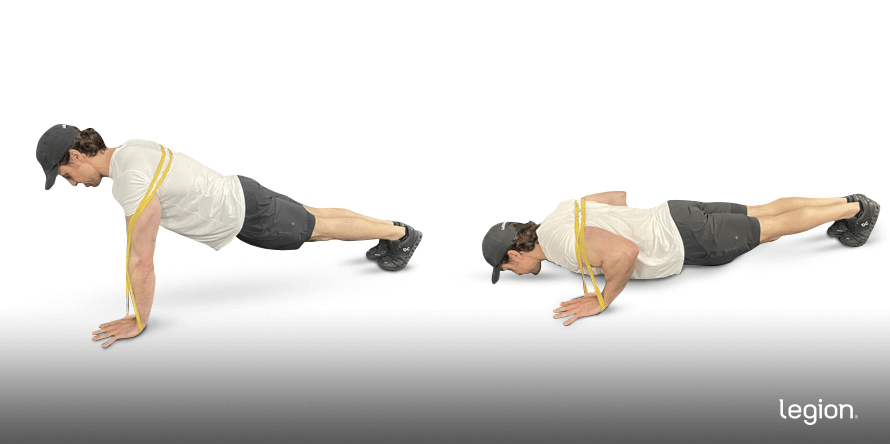
The band push-up involves wrapping a resistance band around your back and pinning the two ends of the band under your hands, then “pressing up” against the band. The band push-up is significantly more difficult than the regular push-up, which is why research shows it’s highly effective for building muscle and gaining strength.
7. Deficit Push-up

The main benefit of the deficit push-up is it trains your muscles through a longer range of motion and in a more stretched position, which is generally better for muscle growth.
To perform the deficit push-up, place two sturdy objects (weight plates, for example) under your hands or use push-up bars, then get into the push-up position and lower your body between the objects until your chest is 1-to-2 inches off the floor.
8. Diamond Push-up
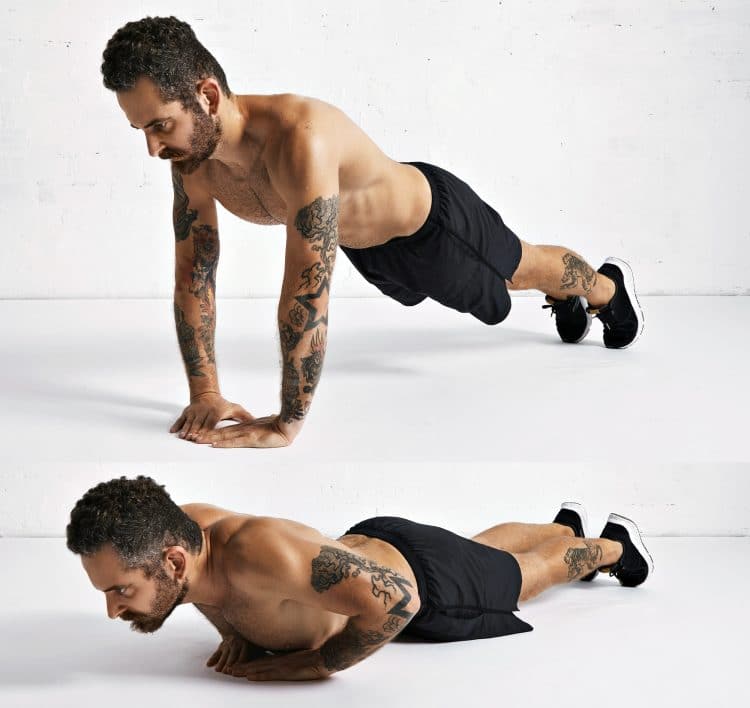
The diamond push-up (sometimes referred to as the triceps push-up) is a push-up variation where you bring your hands together under your chest to form a diamond shape on the floor with your thumbs and forefingers.
Research shows that doing push-ups with your hands close together emphasizes your triceps, making the diamond push-up a good push-up variation if you want to focus on developing your triceps more than your pecs.
9. Pike Push-up
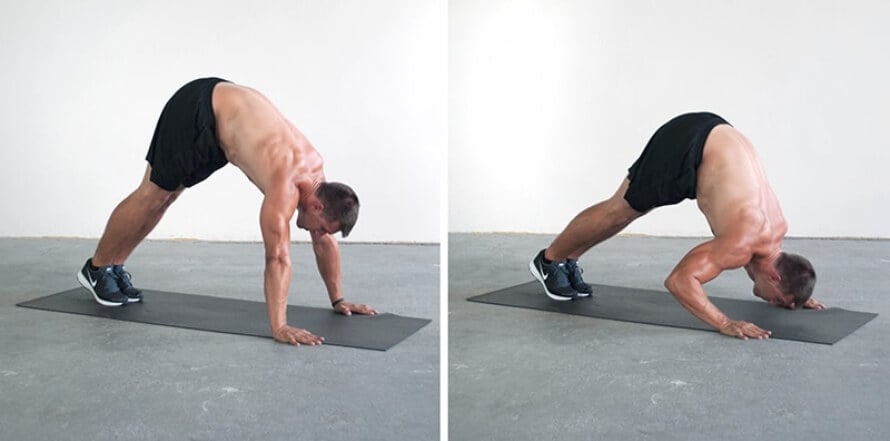
The pike push-up trains your upper body similarly to the handstand push-up. The difference is that in the pike push-up, you keep your feet on the floor, reducing the weight you have to lift.
It also means the pike push-up requires less balance and coordination than the handstand push-up, which means it allows you to progressively build the strength you need to perform the handstand push-up.
10. Archer Push-up
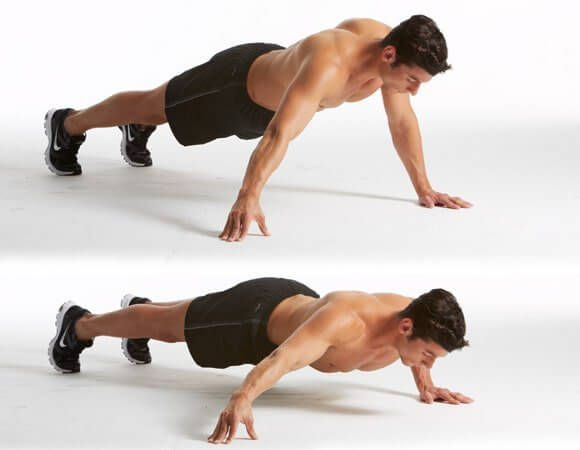
In the archer push-up, you place your hands about twice as wide as shoulder-width, then lower yourself toward one of your hands, allowing your opposite arm to straighten. Once your chest touches your hand, you press through your bent arm to return to the starting position.
The benefit of the archer push-up is it trains each side of your body more or less independently, which helps you identify and correct muscle and strength imbalances because one side can’t “take over” from the other.
However, the archer push-up requires a lot of strength and coordination, so it’s not a viable push-up alternative if you’re new to strength training.
The Best Push-up Workouts
Beginner Push-up Workout
This beginner push-up workout is perfect for people who are new to weightlifting because it involves the push-up variations that help you build a foundation of strength:
- Knee Push-up: 3 sets of 10-to-20 with 2 min rest
- Incline Push-up: 3 sets of 10-to-20 with 2 min rest
Intermediate Push-up Workout
Once you can do 20 reps for all your sets in the Beginner Push-up Workout, progress to this Intermediate Push-up Workout. It’s effective because it contains challenging push-up variations that train your pushing muscles in different ways, from different directions, and at different angles, making it ideal for building upper-body muscle and strength:
Decline Push-up: 3 sets of 10-to-20 with 2 min rest
Deficit Push-up: 3 sets of 10-to-20 with 2 min rest
Pike Push-up: 3 sets of 10-to-20 with 2 min rest
Advanced Push-up Workout
This Advanced Push-up Workout contains all the most demanding push-up variations, so only progress to it once you can do 20 reps for all your sets in the Intermediate Push-up Workout.
- Band Push-up: 3 sets of 10-to-20 with 2 min rest
- Handstand Push-up: 3 sets of 10-to-20 with 2 min rest
- Decline Push-up: 3 sets of 10-to-20 with 2 min rest
- Diamond Push-up: 3 sets of 10-to-20 with 2 min rest
And if you like the look of these workouts and you’d like more for training your entire body, check out my fitness plans for men and women Bigger Leaner Stronger and Thinner Leaner Stronger.
(Or if you aren’t sure if Bigger Leaner Stronger or Thinner Leaner Stronger is right for you or if another strength training program might be a better fit for your circumstances and goals, take Legion Strength Training Quiz, and in less than a minute, you’ll know the perfect strength training program for you. Click here to check it out.)
FAQ #1: What’s the difference between a regular push-up and a military push-up?
The only difference between a military push-up and a regular push-up is that in the military push-up, you keep your elbows slightly closer to your sides as you perform each rep.
For instance, you flare your elbows in the regular push-up so they’re 6-to-8 inches from your torso at the bottom of each rep. Conversely, in the military push-up, you “tuck” your elbow closer to your sides, so they finish each rep 2-to-4 inches from your torso.
FAQ #2: What’s the push-up world record?
In April 2022, Australian Daniel Scali smashed the push-up world record by completing 3,182 push-ups in 1 hour—over 100 more than the previous record of 3,054 achieved by fellow Australian Jarrad Young in 2021.
FAQ #3: Why can’t I do a push-up?
Many people think of the push-up as a “beginner exercise,” but it requires more strength than most realize. Research shows that you must lift ~70-to-75% of your body weight to complete a push-up with proper push-up form. For example, if you weigh 180 pounds, you must lift ~125-to-135 pounds to complete a push-up.
For many new weightlifters, lifting most of their body weight is too much in the beginning. Don’t fret if this is the case for you, though. Follow the Beginner Push-up Workout in this article, and you’ll soon build the strength you need to progress to the regular push-up.
Scientific References +
- Kim, Y. S., Kim, D. Y., & Ha, M. S. (2016). Effect of the push-up exercise at different palmar width on muscle activities. Journal of Physical Therapy Science, 28(2), 446. https://doi.org/10.1589/JPTS.28.446
- Borreani, S., Calatayud, J., Colado, J. C., Moya-Nájera, D., Triplett, N. T., & Martin, F. (2015). Muscle activation during push-ups performed under stable and unstable conditions. Journal of Exercise Science and Fitness, 13(2), 94. https://doi.org/10.1016/J.JESF.2015.07.002
- Uhl, T. L., Carver, T. J., Mattacola, C. G., Mair, S. D., & Nitz, A. J. (2003). Shoulder musculature activation during upper extremity weight-bearing exercise. The Journal of Orthopaedic and Sports Physical Therapy, 33(3), 109–117. https://doi.org/10.2519/JOSPT.2003.33.3.109
- Kwon, Y. J., Park, S. J., Jefferson, J., & Kim, K. (2013). The Effect of Open and Closed Kinetic Chain Exercises on Dynamic Balance Ability of Normal Healthy Adults. Journal of Physical Therapy Science, 25(6), 671. https://doi.org/10.1589/JPTS.25.671
- Kim, M. K., & Yoo, K. T. (2017). The effects of open and closed kinetic chain exercises on the static and dynamic balance of the ankle joints in young healthy women. Journal of Physical Therapy Science, 29(5), 845–850. https://doi.org/10.1589/JPTS.29.845
- Suprak, D. N., Dawes, J., & Stephenson, M. D. (2011). The effect of position on the percentage of body mass supported during traditional and modified push-up variants. Journal of Strength and Conditioning Research, 25(2), 497–503. https://doi.org/10.1519/JSC.0B013E3181BDE2CF
- Alizadeh, S., Rayner, M., Mamdouh Ibrahim Mahmoud, M., & Behm, D. G. (2020). Push-Ups vs. Bench Press Differences in Repetitions and Muscle Activation between Sexes. Journal of Sports Science & Medicine, 19(2), 289. /pmc/articles/PMC7196742/
- Jung, J., & Cho, W. (2015). Effects of push-up exercise on shoulder stabilizer muscle activation according to the grip thickness of the push-up bar. Journal of Physical Therapy Science, 27(9), 2995. https://doi.org/10.1589/JPTS.27.2995
- Ebben, W. P., Wurm, B., Vanderzanden, T. L., Spadavecchia, M. L., Durocher, J. J., Bickham, C. T., & Petushek, E. J. (2011). Kinetic analysis of several variations of push-ups. Journal of Strength and Conditioning Research, 25(10), 2891–2894. https://doi.org/10.1519/JSC.0B013E31820C8587
- Barnett, C., Kippers, V., & Turner, P. (n.d.). Effects of Variations of the Bench Press Exercise on the EMG... : The Journal of Strength & Conditioning Research. Retrieved December 24, 2022, from https://journals.lww.com/nsca-jscr/Abstract/1995/11000/Effects_of_Variations_of_the_Bench_Press_Exercise.3.aspx
- Lauver, J. D., Cayot, T. E., & Scheuermann, B. W. (2016). Influence of bench angle on upper extremity muscular activation during bench press exercise. European Journal of Sport Science, 16(3), 309–316. https://doi.org/10.1080/17461391.2015.1022605
- Trebs, A. A., Brandenburg, J. P., & Pitney, W. A. (2010). An electromyography analysis of 3 muscles surrounding the shoulder joint during the performance of a chest press exercise at several angles. Journal of Strength and Conditioning Research, 24(7), 1925–1930. https://doi.org/10.1519/JSC.0B013E3181DDFAE7
- Uzunov, V. (n.d.). (PDF) Developing the Straddle Sit Press to Handstand. Retrieved December 24, 2022, from https://www.researchgate.net/publication/281149742_Developing_the_Straddle_Sit_Press_to_Handstand
- Johnson, A., Meador, M., Bodamer, M., Langford, E., & Snarr, R. L. (2019). Exercise technique: Handstand push-up. Strength and Conditioning Journal, 41(2), 119–123. https://doi.org/10.1519/SSC.0000000000000427
- Calatayud, J., Borreani, S., Colado, J. C., Martin, F., Tella, V., & Andersen, L. L. (2015). Bench press and push-up at comparable levels of muscle activity results in similar strength gains. Journal of Strength and Conditioning Research, 29(1), 246–253. https://doi.org/10.1519/JSC.0000000000000589
- Kikuchi, N., & Nakazato, K. (2017). Low-load bench press and push-up induce similar muscle hypertrophy and strength gain. Journal of Exercise Science and Fitness, 15(1), 37–42. https://doi.org/10.1016/J.JESF.2017.06.003
- Schoenfeld, B. J., & Grgic, J. (2020). Effects of range of motion on muscle development during resistance training interventions: A systematic review. SAGE Open Medicine, 8, 205031212090155. https://doi.org/10.1177/2050312120901559
- Oranchuk, D. J., Storey, A. G., Nelson, A. R., & Cronin, J. B. (2019). Isometric training and long-term adaptations: Effects of muscle length, intensity, and intent: A systematic review. Scandinavian Journal of Medicine & Science in Sports, 29(4), 484–503. https://doi.org/10.1111/SMS.13375
- Marcolin, G., Petrone, N., Moro, T., Battaglia, G., Bianco, A., & Paoli, A. (2015). Selective Activation of Shoulder, Trunk, and Arm Muscles: A Comparative Analysis of Different Push-Up Variants. Journal of Athletic Training, 50(11), 1126. https://doi.org/10.4085/1062-6050-50.9.09
- Kim, Y. S., Kim, D. Y., & Ha, M. S. (2016). Effect of the push-up exercise at different palmar width on muscle activities. Journal of Physical Therapy Science, 28(2), 446. https://doi.org/10.1589/JPTS.28.446
- Barakat, C., Barroso, R., Alvarez, M., Rauch, J., Miller, N., Bou-Sliman, A., & De Souza, E. O. (2019). The Effects of Varying Glenohumeral Joint Angle on Acute Volume Load, Muscle Activation, Swelling, and Echo-Intensity on the Biceps Brachii in Resistance-Trained Individuals. Sports (Basel, Switzerland), 7(9). https://doi.org/10.3390/SPORTS7090204
- Suprak, D. N., Dawes, J., & Stephenson, M. D. (2011). The effect of position on the percentage of body mass supported during traditional and modified push-up variants. Journal of Strength and Conditioning Research, 25(2), 497–503. https://doi.org/10.1519/JSC.0B013E3181BDE2CF










